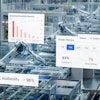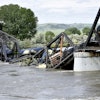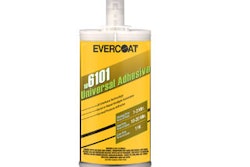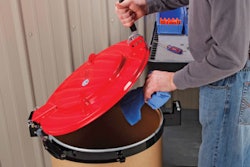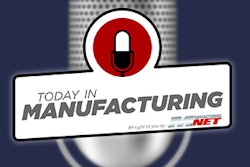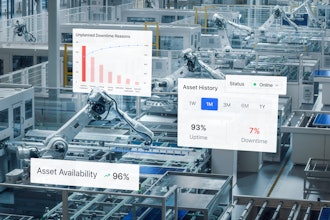This article first appeared in IMPO's June 2012 issue.
Used in everything from cleaning to metal work, abrasives efficiency and safety are taking center stage for many manufacturers.
Abrasives are playing an important role in present-day production methods. Used in the manufacture of most durable goods and raw material production, Saint-Gobain’s Patrick Redington, director of application engineering, says he has seen the domestic demand for abrasives “rise substantially since the recession of 2009.” With vehicle sales on the rise and the aerospace and steel industries forecasted to grow as well, manufacturing companies are investing in new technologies with an eye on efficiency, safety, and productivity.
“These new technologies and a reevaluation of the total cost of outsourcing have increased production demands,” Redington says, “which in turn has increased the abrasives demand.” The need for higher performance components has lead to tighter tolerances in processes such as precision grinding, and newer high strength materials being used.
Automatic Abrasion
Long considered a low-tech operation, industrial grinding has become a vital process requiring high levels of precision and control. To stay competitive in a global marketplace while providing a safe working environment, U.S. manufacturers are constantly looking for ways to improve manual operations, and abrasive processes are no exception. As a result, automation — and robotic technology — is rapidly evolving. “In the robotic world, advanced vision and force sensing technologies are being developed that will allow the robot to ‘see’ and ‘feel’ the work piece they are processing,” explains Redington. “These technologies allow the robot to bring the work piece to the abrasive media (or visa-versa) much like a human would, only in a more consistent and safe manner, thus reducing a manufacturer’s scrap rates and lost time injuries.” Robotic polishing, buffing, and grinding workstations can be run 24 hours per day, 7 days a week, year round while eliminating a potentially dangerous manufacturing process.
Manufacturers are also investigating semi-automated technologies that can take operators one step away from the process to reduce the chances of an injury occurring. Manipulation devices, such as joysticks, give an operator control of the abrasive process while removing the need to physically manipulate the work piece or the abrasive media. Redington explains, “the ultimate objective for many manufacturers is a lights out operation combining the reliability of automation processes, modern CNC controls, and remote monitoring systems with new long life, robust grinding strategies.”
Abrasive Efficiency
With the resurgence in capital equipment investment, there is an entire process reevaluation, says Redington. “There is an enormous demand for improved technical performance of both conventional and superabrasive grain.” New higher strength materials with tighter process requirements are providing opportunities to reconsider grinding over more traditional processes such as broaching or milling for high stock removal while tighter demands on finish — in addition to eliminating polishing entirely — is driving research on wheel surface morphology and work piece interactions. “New metal hybrid bonds are moving the technology away from conventional resin bonds for both CBN and diamond in the tooling industries,” Redington explains. “At the forefront of grinding in general is the expanding family of engineered alumina grains with controlled morphology and microstructure.”
Targeted to specific levels of grain fracture, these new abrasives provide options for stock removal rates that can exceed current machining processes and offer an alternative for very burn-sensitive materials. Due to their inherent strength and high resistance to dulling, these engineered alumina grains are ideal for bonded, coated, and cut-off wheel applications, like the grinding of stainless steel. Their extremely fine crystalline microstructure allows for one of the most durable materials in the abrasives industry, even surpassing brown fused aluminum oxide and silicon carbide.
Training For Safety, Efficiency
“Safety is always a concern,” says Andy Mandell, marketing manager with Dynabrade. He emphasizes that the best way to address safety issues is to “be certain the customer knows how to properly use the tool, knowing all of the features and benefits before operating.” Manufacturers understand the importance of training in their workforce, and abrasives training is no different. “The importance of training cannot be overstated when working with abrasives,” says PFERD’s Phillip Benincaso, training manager and applications specialist. Benincaso stresses that training for the proper selection and usage of abrasives is critical for two main reasons: safety and proper abrasives selection, which directly impact cost and productivity.
First and foremost, Benincaso says, is safety. “Using the incorrect abrasive product, or the misuse of a power tool for a specific application, can result in serious injury or even death.” Due to the inherent danger in running tools that rotate at extremely high speeds, the appropriate personal protective equipment is essential when employing abrasive products. This includes eye protection, a face shield, gloves, hearing protection, breathing protection, and protective clothing as required by the safety personnel or employer.
“Training further adds to the understanding of the correct way to operate a power tool,” Benincaso adds. A power tool such as an angle grinder can be very versatile, allowing operators to cut, grind, and finish a variety of metals. “Because of this versatility, they are widely used,” he adds, “and in many cases, misused.” Calling attention to the importance of a power guard, he explains that a power tool’s guard — which serves to protect the operator in case of tool failure — also prevents an operator from putting a larger than recommended wheel on a power tool that exceeds that wheel’s maximum RPM rating. “Featuring power tools with the correct safety features is paramount,” adds Mandell.
Secondly, Benincaso says, training can increase the understanding of how to properly select which abrasives to use, which is essential to reducing costs and increasing productivity. “Quite often, people focus on the ‘up front’ cost of abrasive products without much consideration toward product performance,” he explains. “It is important to understand that the most expensive part of an offhand abrasive application is the cost of labor.”
In addition to selecting the appropriate abrasives, he adds that training is crucial in understanding how to measure product performance as well as knowing how fast an operator can safely get a job done. The answers to some basic questions can aid an operator in understanding what abrasive product is best suited to a particular application: which material will be worked on (steel, stainless steel, aluminum, etc.), what the application is (weld removal, edge grinding, cutting, etc.), and what type of power tool is to be used — and its output (wattage or amperage). “Once you have answers to questions such as these, you can determine the most appropriate abrasive for an application,” says Benincaso.
Another major safety issue for many manufacturers is dust. Abrasive materials used for the cutting and grinding of metals and other materials create dust, which can cause eye and respiratory irritation, or abrasive injury to the eyes. Many materials, including recycled steel scrap, can also create flammable or explosive dusts or turnings when machined or ground. “Vacuum tools that eliminate dust are a very important issue in today’s working environments,” Mandell says. In addition to vacuum tools, PPE is an integral part of reducing worker dust exposure. “A clean and safe working environment is very important for today’s manufacturers.”
Evaluating Costs
“Labor costs, tool change-up times, and metal removal rates all serve as factors in the overall costs of a tool,” says Rick Shagoury, marketing communications manager with PFERD. He adds that the most important factors for an industrial manufacturer to consider when purchasing abrasives equipment “depend on some degree on the end user and application, but generally the considerations boil down to cost.” The total cost of abrasives equipment is not only the initial purchase price of a tool, but also the tool life and increased labor efficiency that a tool can provide.
“Anyone can sell a power tool,” Mandell says, “but it takes a real professional to counsel the customer in regard to purchasing the right tool for the job.” Many abrasives tools suppliers offer services to help industrial manufacturers analyze their grinding operations to reduce rejection and scrap rates, driving costs down to help make operations more profitable. Redington explains, “during our assessment process, we work to understand the customer’s process and determine their needs, document a baseline, and mutually align on improvement.” These services allow customers to deliver added value in the areas of cost, quality, safety, and service.
Driven by the demand for manufactured industrial products, abrasive manufacturers are making significant investments to successfully compete in today’s global and competitive marketplace. Says Shagoury, “the most common goal across the board is the desire to reduce equipment and labor costs, and increase productivity.”


